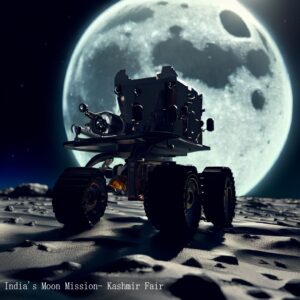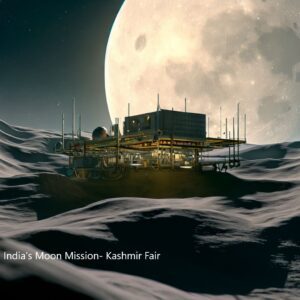India’s Moon Mission-Chandrayaan-3
India’s Moon mission, Chandrayaan-3, marked a significant milestone in the country’s space exploration endeavors. Launched by the Indian Space Research Organization (ISRO) on July 14, 2023, this ambitious mission aimed to further our understanding of Earth’s celestial neighbor and solidify India’s reputation as a burgeoning space power.
Chandrayaan-3 followed in the footsteps of India’s first lunar mission, Chandrayaan-1, which was launched in 2008 and made significant discoveries, including the detection of water molecules on the Moon’s surface. Chandrayaan-3, however, was a more complex and daring mission as it consisted of an orbiter, a lander, and a rover.
- The Orbiter: The mission’s orbiter is designed to study the Moon’s surface and its exosphere, the outermost layer of the Moon’s atmosphere. It carried a suite of scientific instruments, including cameras and spectrometers, to capture high-resolution images and collect data about the lunar terrain, mineral composition, and topography. The orbiter would also serve as a vital communication link between Earth and the lander.
- The Lander (Vikram): The lander, named Vikram, was tasked with making a soft landing near the Moon’s south pole, a region of particular interest due to its unique geological features and potential water ice deposits. Vikram was equipped with instruments to measure seismic activity and study the thermal properties of the lunar surface. Its successful landing was anticipated to be a historic moment for India, as only a handful of nations had achieved such a feat.
- The Rover (Pragyan): Once the Lander safely touched down, it was supposed to deploy the rover, named Pragyan. The rover was designed to explore the lunar surface, collect soil and rock samples, and conduct experiments to better understand the Moon’s composition and history. It has the capability to move around on wheels and communicate with the orbiter and Earth.
Chandrayaan-3 demonstrated India’s technical capabilities in space exploration and highlighted its commitment to advancing scientific knowledge. India’s Moon Mission-Chandrayaan-3


Why to explore moon? India’s Moon Mission-Chandrayaan-3
Exploring the Moon offers numerous scientific, technological, and strategic benefits, which is why space agencies and scientists from around the world are interested in lunar exploration. Here are some compelling reasons to explore the Moon:
- Scientific Discovery: The Moon is often referred to as a “time capsule” of the early solar system. Studying the Moon’s surface and geology can provide insights into the formation and evolution of celestial bodies, including Earth. It can help answer questions about the origins of our solar system and the processes that shaped planetary bodies.
- Understanding Earth: By comparing the Moon to Earth, scientists can gain a deeper understanding of our planet’s history, geological processes, and climate evolution. For example, studying lunar craters can provide insights into the history of asteroid impacts on Earth, which is crucial for planetary defense efforts.
- Resource Potential: The Moon may contain valuable resources such as water ice and minerals. Water ice can be converted into drinking water and used for rocket fuel, making the Moon a potential stepping stone for further exploration of our solar system. Lunar regolith also contains various minerals that could be mined for use in space industries.
- Technological Advancements: Lunar exploration drives innovation in technology and engineering. Developing systems for lunar missions can lead to advancements in robotics, communication, navigation, and space travel, which can have applications beyond lunar exploration.
- International Collaboration: The Moon serves as a platform for international collaboration in space exploration. Collaborative lunar missions promote cooperation among nations and can lead to the sharing of scientific data, resources, and expertise.

India’s Moon Mission-Chandrayaan-3 - Space Exploration Training: The Moon provides a relatively close and accessible destination for training astronauts and testing spacecraft and equipment before embarking on more distant missions, such as those to Mars or beyond.
- Inspiration and Education: Lunar missions capture the imagination of people worldwide, inspiring the next generation of scientists, engineers, and explorers. They also offer educational opportunities to learn about space science, technology, and the importance of protecting Earth.
- Strategic Interests: Space, including the Moon, has strategic importance for national security, communications, and surveillance. Understanding the lunar environment and potentially establishing a presence there can serve strategic interests.
- Space Tourism: The Moon has the potential to become a destination for space tourism in the future. As technology advances and commercial space ventures expand, lunar tourism could become a reality, opening up new opportunities for recreation and adventure.
- Global Perspective: Lunar exploration encourages a global perspective on Earth and space. Seeing Earth from the Moon can reinforce the importance of environmental stewardship and international cooperation.
In summary, exploring the Moon is not only scientifically intriguing but also holds the potential for technological innovation, resource utilization, and international collaboration. It is a steppingstone for humanity’s continued exploration of space and offers valuable insights into our own planet and the broader cosmos.
Why India enterprises to explore moon on the dark side? India’s Moon Mission-Chandrayaan-3
India had not officially announced plans to explore the “dark side” of the Moon. However, it’s important to clarify a few points regarding the concept of the “dark side” of the Moon:
- Misconception about the “Dark Side”: The term “dark side” of the Moon is a bit misleading. It doesn’t refer to a region that is permanently dark or unilluminated. In fact, all parts of the Moon receive sunlight during its various phases, but the Moon has a far side that is never visible from Earth due to synchronous rotation. This means that the same side of the Moon always faces the Earth, while the far side, also known as the “dark side” in popular culture, faces away.
- Scientific Interest: The far side of the Moon is of particular scientific interest because it is shielded from Earth’s radio-frequency interference, making it an excellent location for radio astronomy and studying cosmic phenomena without terrestrial interference. It also has unique geological features that scientists are keen to explore.
- Lunar Exploration: Several lunar missions from different countries, including China’s Chang’e-4, have targeted the far side of the Moon in recent years. These missions have contributed significantly to our understanding of this unexplored region.
If India has since announced plans to explore the far side of the Moon or any other lunar region, it would be a significant development in its space exploration endeavors.
What is south pole of moon?
The South Pole of the Moon is one of the two points on the Moon’s surface where its axis of rotation intersects the lunar surface, with the other being the North Pole. The South Pole of the Moon has several distinctive features and characteristics:

- Topography: The lunar South Pole is marked by a rugged and uneven terrain. It consists of highlands and lowlands, and there are numerous craters and mountainous regions in this area.
- Permanently Shadowed Craters: One of the most intriguing features of the lunar South Pole is the presence of permanently shadowed craters. These craters are located in regions where the Sun’s rays never reach, making them incredibly cold and dark. These areas are believed to be some of the coldest places in the solar system. Water ice is thought to exist in these permanently shadowed regions because of the extreme cold.
- Water Ice Deposits: Recent lunar missions, including NASA’s Lunar Reconnaissance Orbiter (LRO) and India’s Chandrayaan-2, have provided evidence of water ice deposits in these permanently shadowed craters near the South Pole. This discovery is of great interest to future lunar exploration efforts, as water could potentially be used for life support, fuel, and as a resource for future lunar colonies.
- Scientific Interest: The South Pole of the Moon is of significant scientific interest due to its unique geological features, its potential as a source of water ice, and its suitability for astronomical observations. It is an area where scientists can learn more about the Moon’s history, geology, and possibly gain insights into the early history of the solar system.
- Future Exploration: The South Pole region of the Moon is a focus of interest for future lunar exploration missions. Several space agencies, including NASA, have plans to send astronauts to the Moon in the coming years as part of the Artemis program, and the lunar South Pole is considered a prime destination for these missions.
In summary, the South Pole of the Moon is a region of great scientific importance and interest due to its unique geological features, the discovery of water ice, and its potential as a destination for future human lunar exploration missions.
Is there any possibility to settle human beings on moon?
Yes, there is a possibility of settling human beings on the Moon in the future, and this idea has been a subject of serious consideration and planning by space agencies and organizations worldwide. Here are some key factors contributing to the possibility of human settlement on the Moon:
- Advancements in Space Technology: Continuous advancements in space technology, including spacecraft design, propulsion systems, and life support systems, are making lunar missions and prolonged stays on the Moon more feasible.
- International Collaboration: Many countries and space agencies are interested in lunar exploration and are collaborating on missions and infrastructure development. This international cooperation can contribute to the development of lunar habitats and sustainable settlement.
- Resource Utilization: The Moon is believed to have valuable resources such as water ice and minerals. Water can be converted into drinking water and used for rocket fuel, while lunar regolith can be processed for various materials. These resources can support human settlement and make it more sustainable.
- Scientific and Commercial Interests: Lunar settlement offers opportunities for scientific research, including studying the Moon’s geology and conducting experiments in a unique environment. Additionally, commercial interests, such as mining lunar resources, may drive investment in lunar activities.
- Testing Ground for Mars: Establishing a sustainable presence on the Moon can serve as a valuable testing ground for technologies and strategies that will be needed for future human missions to Mars and beyond.
- Artemis Program: NASA’s Artemis program aims to return astronauts to the Moon, including the goal of establishing a sustainable human presence there by the mid-2020s. This program, along with international partnerships, is a significant step toward lunar settlement.
- Private Space Companies: Private space companies like SpaceX and Blue Origin have expressed interest in lunar exploration and settlement. Their involvement may accelerate progress in lunar activities.
Challenges to lunar settlement include radiation exposure, extreme temperature variations, and the need for life support systems. However, ongoing research and development are focused on addressing these challenges.
It’s important to note that while the possibility of lunar settlement is real, it may take several years or even decades to establish a self-sustaining human presence on the Moon. International collaboration, technological advancements, and a long-term commitment to lunar exploration will play key roles in making lunar settlement a reality.
What is lunar settlement?
A lunar settlement refers to a permanent or semi-permanent human presence on the Moon. It involves establishing facilities and infrastructure that can support astronauts or colonists living and working on the lunar surface for extended periods of time. Lunar settlements represent a significant step in humanity’s exploration and potential colonization of space beyond Earth.


Key characteristics of a lunar settlement include:
- Habitats: Lunar habitats are structures where astronauts or residents can live and work safely. These habitats must provide protection from the harsh lunar environment, including extreme temperatures, micrometeoroid impacts, and radiation.
- Life Support Systems: To sustain human life, lunar settlements require life support systems that provide breathable air, clean water, and waste recycling. These systems must be capable of functioning independently or with minimal resupply from Earth.
- Resource Utilization: To reduce reliance on Earth for resources, lunar settlements may employ in-situ resource utilization (ISRU) techniques. This involves extracting and using local resources, such as water ice, for drinking water, oxygen production, and hydrogen for rocket fuel.
- Energy Sources: Lunar settlements would need a reliable source of energy. Solar panels are a likely choice for generating electricity, as the Moon receives continuous sunlight for about two weeks at a time during its day.
- Scientific Research: Lunar settlements would serve as bases for scientific research, including studying lunar geology, conducting experiments in the unique lunar environment, and potentially using telescopes for astronomical observations.
- Commercial Activities: In the long term, lunar settlements could support commercial activities such as mining for valuable lunar resources, tourism, and manufacturing.
- International Collaboration: Collaboration among space agencies and countries is essential for the establishment and sustainability of lunar settlements. Cooperative efforts can share the cost and expertise required for such endeavors.
Several space agencies, including NASA with its Artemis program, and private space companies have expressed interest in establishing lunar settlements in the coming decades. These efforts aim to not only expand our understanding of the Moon but also serve as stepping stones for future human exploration of Mars and beyond.
While the concept of lunar settlements is exciting, it also presents significant challenges, including radiation exposure, long-duration space travel, and the need for robust life support systems. Overcoming these challenges is a priority for space agencies and organizations interested in lunar colonization.


Can India achieve its moon mission?
India had already achieved several significant milestones in lunar exploration, notably with the Chandrayaan-1 mission in 2008 and the launch of Chandrayaan-2 in 2019. While Chandrayaan-2 faced challenges with the loss of communication with its lander during its descent to the lunar surface, the mission’s orbiter continued to function and gather valuable data.
India’s space agency, the Indian Space Research Organization (ISRO), has demonstrated its capabilities in space technology and exploration. ISRO has a history of successful missions, including missions to Mars (Mangalyaan) and numerous satellite launches.

ISRO, like any space agency, faces technical challenges and risks in its missions, but it has shown resilience and a commitment to learning from both successes and setbacks. Whether or not India achieves its moon mission goals depends on various factors, including technical readiness, funding, international collaboration, and the ability to adapt and overcome challenges.
It’s important to note that space exploration is a complex endeavor, and setbacks are not uncommon. Even experienced space agencies face challenges in missions to the Moon and beyond. The pursuit of lunar exploration and other ambitious space goals is driven by the desire for scientific discovery, technological advancement, and international collaboration.
*Images used are AI Generated
Read Also:
What is Artificial Intelligence?
What is India’s Moon Mission?
India’s Moon mission, Chandrayaan-3, marked a significant milestone in the country’s space exploration endeavors. Launched by the Indian Space Research Organization (ISRO) on July 14, 2023, this ambitious mission aimed to further our understanding of Earth’s celestial neighbor and solidify India’s reputation as a burgeoning space power.
Why to explore moon?
Exploring the Moon offers numerous scientific, technological, and strategic benefits, which is why space agencies and scientists from around the world are interested in lunar exploration. Here are some compelling reasons to explore the Moon:
Can India achieve its moon mission?
India had already achieved several significant milestones in lunar exploration, notably with the Chandrayaan-1 mission in 2008 and the launch of Chandrayaan-2 in 2019. While Chandrayaan-2 faced challenges with the loss of communication with its lander during its descent to the lunar surface, the mission’s orbiter continued to function and gather valuable data.






